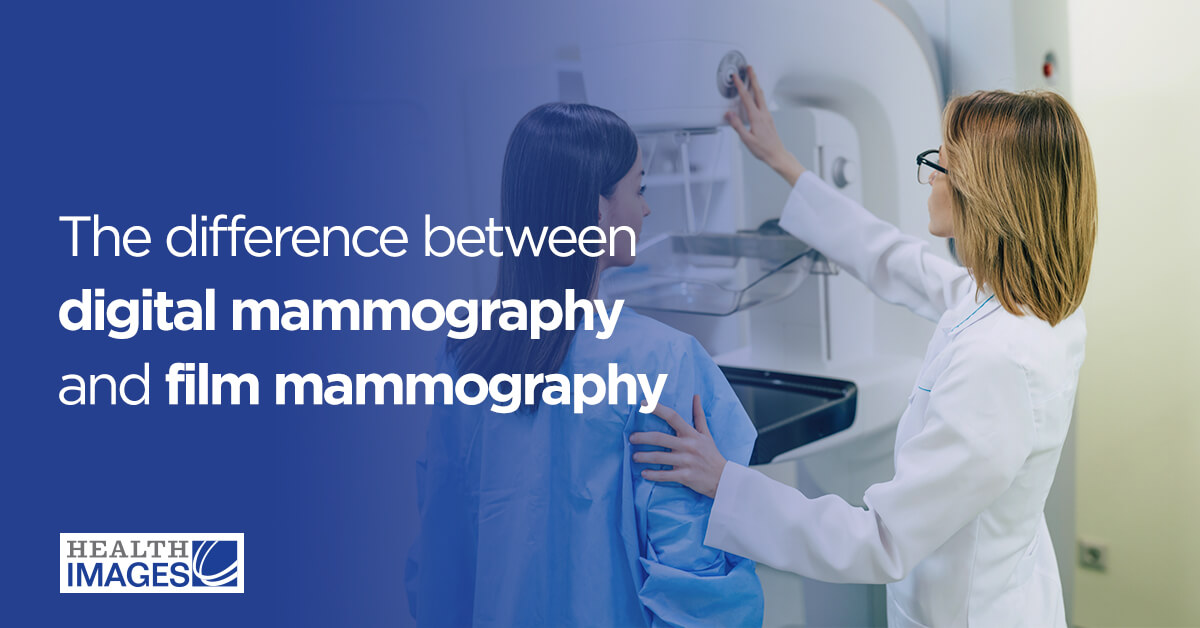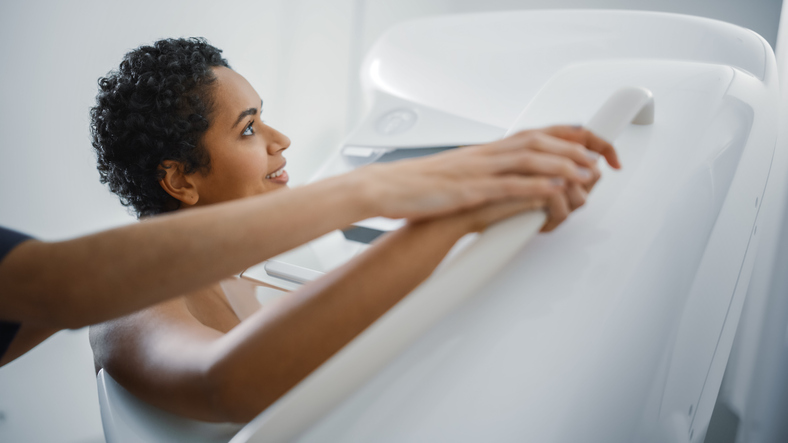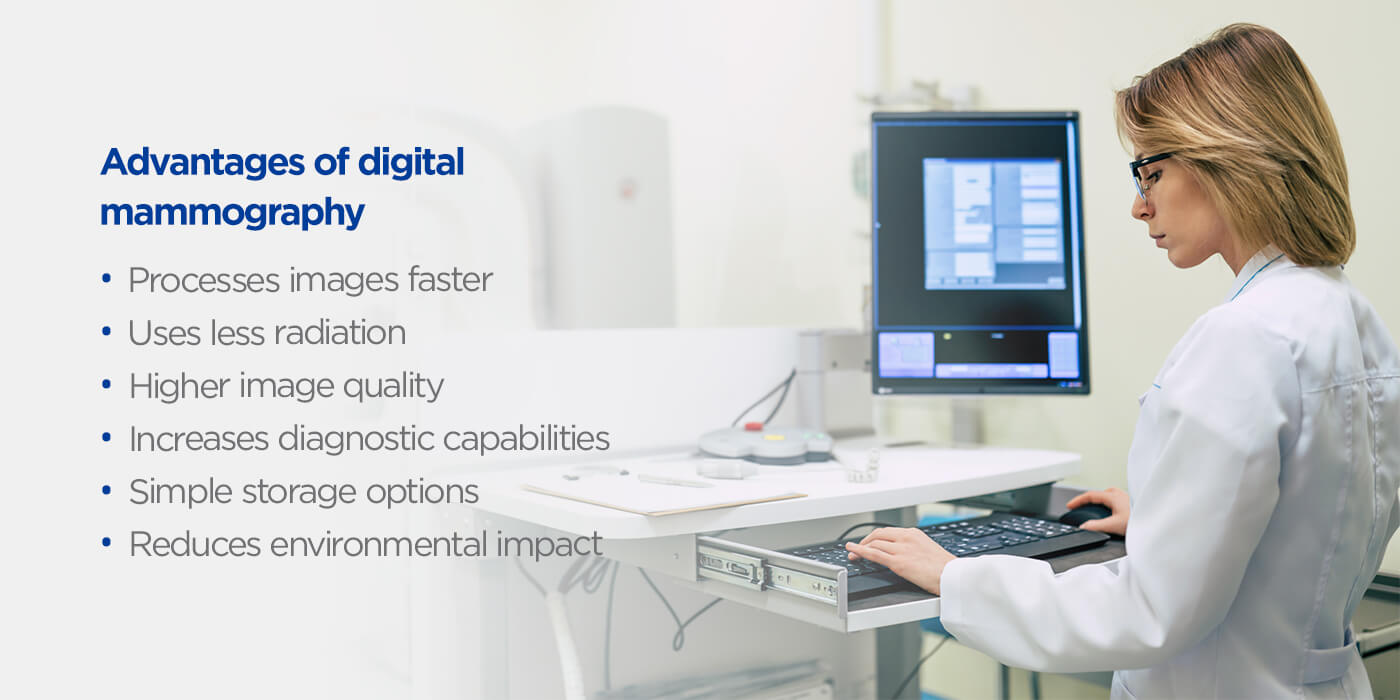The difference between digital mammography and film mammography

Scheduling a mammography appointment is one of those things you may feel like putting off until it is necessary. The good news is that mammography is safe, quick and effective at ruling out abnormalities in breast tissue. While some discomfort is natural during the exam, it only lasts a few seconds at a time.
Whether you are dreading mammography, couldn’t be bothered or have some questions, you may benefit from learning more about this exam. Mammography technology has made several advancements over the past 50 years. One of the most significant advancements is the switch from film to digital mammography.
Jump to Sections:
- What is film mammography?
- What is digital mammography?
- What are the advantages of digital mammography?
- Visit a Health Images center near you for 3D digital mammography
What is film mammography?
In the 1970s, screen-film mammography signaled a considerable breakthrough in breast tissue imaging. The old guard it replaced used basic X-ray technology to produce foggy images that were difficult to analyze and took time to process. In contrast, screen-film mammography used less radiation, processed images faster and produced clearer images. Screen-film mammography benefited everyone — patients, physicians, technologists and lab analysts.
Like the traditional X-ray, screen-film mammography stores images of breast tissue on film. The film mammography process is also similar to X-ray imaging.
However, mammography differs from regular X-rays because it uses compression on the breast tissue. Since the breast tissue has dense layers of tissue, compression helps get a clear image of any abnormalities within the tissue.
As the plate compresses your breast tissue, you will likely feel some discomfort. However, the compression only occurs for a few seconds at a time. The discomfort experienced with mammography is related to breast density, not size. There is a myth smaller breasts experience more pain with mammography. However, size does not impact discomfort levels. That said, technologists sometimes have more difficulty getting clear images of breasts with dense tissue. The adjustments they make to acquire clear images may cause added discomfort for patients.
During screen-film mammography, your doctor will ask you to remove your shirt and bra in a private room. They will also provide you with a wrap to cover yourself. Once you are ready, a screen-film mammogram occurs in the following steps:
- Standing in front of the X-ray machine, you will place one breast on a plastic platform at a time.
- The X-ray technician lowers a plastic plate to compress your breast tissue.
- The technician keeps the breast tissue compressed for a few seconds then raises the plate.
- They will ask you to reposition your breast, so they scan the sides of your breast.
- The technician lowers the plastic plate to scan the tissue for a few seconds then raises the plate.
Once they have scanned the tissue sufficiently, they process the images through a cassette that contains a screen and film. A phosphor coating in the cassette glows and exposes the film to the X-rays, causing the film to develop similar to a photograph. Screen-film mammograms take approximately 20 minutes to complete.
What is digital mammography?
As the turn of the century approached, the novelty of screen-film mammography began to fade with the advent of digital mammography. Digital mammography matched and exceeded the improvements that screen-film made over conventional mammography. Film mammography produced clearer images faster than their slower and foggier predecessors. Digital mammography did the same to film.
The process for performing digital mammography is largely the same. The main difference between digital mammography and film mammography is how the images are stored. With screen-film mammography, images are stored in hard files of phosphor-coated film. In contrast, digital mammography stores the X-ray images on computers, similar to the way a digital camera takes and stores images.
The data gathered from a digital mammogram is converted into electrical signals that a computer can read and process. This process occurs within seconds. Comparatively, screen-film mammograms take several minutes to process and require a darkroom. Due to increased efficiency, most clinics now use digital mammography instead of film.
What are the advantages of digital mammography?
Screen-film mammography remains an effective tool for detecting breast cancer. With that said, digital mammography has clear advantages. Here are some of the key benefits of digital mammography over film.
Processes images faster
With faster image processing, digital mammography shortens examinations by 11 minutes on average. For doctors, those 11 minutes enable increased productivity to serve patients better. For you, it may mean you can return to work faster or give you time to grab a coffee before your lunch break is over. It also shortens the time you spend waiting for your results.
Uses less radiation
Digital mammography uses less radiation than screen-film mammography in a few different ways. It is quicker and usually requires fewer retakes. Whereas screen-film mammography has a retake rate of approximately 5%, digital mammography is around 1%. The lower retake rate limits the amount of radiation exposure patients experience during the exam.
The radiation dose in digital mammography is approximately 50% less than screen-film mammography. Film mammography already delivers a small radiation dose. As such, the health risks of digital mammography are considerably reduced.
Higher image quality
Digital mammography produces higher-quality images through digital sensors that increase resolution and clarity. Technicians can enhance, magnify or adjust contrasts much easier than film mammograms. Digital mammography simplifies the analysis and diagnosis of breast abnormalities.
Increases diagnostic capabilities
On the subject of diagnosis, digital mammography also includes computer-aided detection capabilities. As radiologists and computers analyze the image, this reduces the risk of missing important details. This feature minimizes false diagnoses and can lead to earlier detection of cancerous cells.
Simple storage options
Whereas film mammograms use lots of storage space, digital mammograms only use virtual space. Digital mammography conserves space in the office and reduces clutter. That’s not all, though, as this feature also provides diagnostic benefits! The virtual storage of digital mammograms also makes it easier to send the image to other doctors for a second opinion or further analysis.
Reduces environmental impact
Processing film images requires using several toxic chemicals. These include formaldehyde, hydroquinone, acetic acid and others. Disposing of these chemicals requires concrete steps to avoid contaminating the environment. Digital mammography eliminates the use of these chemicals and the risk of improper hazardous waste disposal.
Visit a Health Images center near you for 3D digital mammography
At Health Images, our main priority is the health of our patients and community. To provide the best healthcare to our patients and communities, we strive to equip our clinics with advanced technology. We proudly offer 3D digital mammography services in our various centers throughout Colorado. If you need mammography services, we welcome you to find a center near you to discover the benefits of 3D digital mammography!





